After a year of rising costs, cautious consumerism and economic uncertainty across North America, there’s a tantalizing scent of optimism in the spring air.
Central banks are contemplating when to ease their policy rates, which started inching up in the second quarter of 2022. While consumers have been experiencing financial anxiety over interest rates and the cost of living, the impact of tightened monetary policy is now being felt on slowing cost increases. Predictions are that the financial pain of the past interest rate increases will peak before summer.
Nowhere is that more apparent than across the United States, where confidence is palpable. A possible recession evaporated before it got started and signs are increasingly clear that inflation is easing. The U.S. economy is expected to outshine and outperform other G7 countries this year and into 2025. Although the U.S. Federal Reserve chair Jerome Powell is expected to remain cautious, long-awaited changes to the interest rate are expected before the end of the year, while easing of the quantitative tightening is slated to start in June. For Canadian exporters, the net effect is good: With a strong U.S. economy comes demand for Canadian goods, particularly agri-food and energy.
Mexico is also experiencing a spring awakening, thanks to an economy running in top gear, with its growth expected to lead North America now and into 2025. Buoyed by low unemployment, strong remittances, demand for Mexican goods and tourism, and an early move on clawing back the policy rate ahead of many other jurisdictions, the country’s real gross domestic product (GDP) is forecast to grow by 2.4% this year and another 2.2% in 2025.
In Canada, despite weak domestic demand by nervous consumers and businesses, optimism for the next few quarters is slowly lifting, driven by the belief that the Bank of Canada will cut policy rates in June. For Canadian businesses and exporters, the extra breathing room on loan rates and financing is welcome and may somewhat counter the still-soft domestic outlook as households struggle with high debt burden. By this time next year, Canada’s footing will be stronger, benefiting from the ripple effects of the robust U.S. and Mexican economies.
While the pandemic’s economic impacts continue to be felt, we’ve been witnessing a historically unique situation in which all three North American markets simultaneously experienced inflation, price runs and rate hikes. Yet, each has performed differently and each now faces its own challenges in 2024, particularly as this year will see a record-breaking number of national elections impacting more than two billion voters worldwide. Some of those elections, including those in Mexico and the United States, will directly affect all three North American economies with policy shifts and possible disruption. For now, the lookahead is a balance between fiscal restraint and steady growth.
Despite dire warnings of job losses and gloomy headlines about a possible recession triggered by high interest rates and cost of living increases, the U.S. economy flipped the script and expanded by 2.5% in 2023. What’s more, the increase was slightly ahead of the performance of the decade before 2020. This year, it’s expected to advance by another 2.3% and 1.8% in 2025. Even so, the full impact of the Federal Reserve’s policy easing won’t be fully felt immediately, as the unwinding of the policy rate takes time to make its way through the economy.
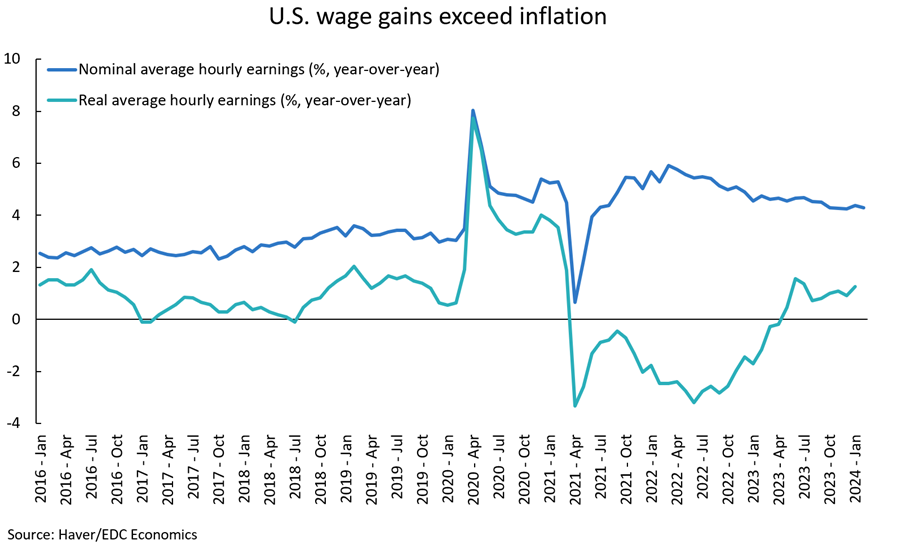
Part of the strength in the U.S. economy lies with a strong labour market. Gains in wage growth are running above inflation, so real earnings of workers are positive and are slightly ahead of the 10-year, pre-COVID-19 growth trend. At the same time, there are 8.8 million job vacancies, with fewer workers leaving their employment, indicating labour market strength.
Even so, consumers face several hurdles until the policy rate reaches a neutral state. Any excess savings shored up during the pandemic have generally been used either on delayed major expenses or travel. And for 44 million people with student loans, repayments are taking a dent out of monthly budgets.
In many areas, like vehicle maintenance, insurance and housing, core inflation hasn’t budged. This will result in the Feds maintaining a steady hand on rate cuts until June 2024, giving them enough lead time to assess progress towards inflation policy goal of 2%.
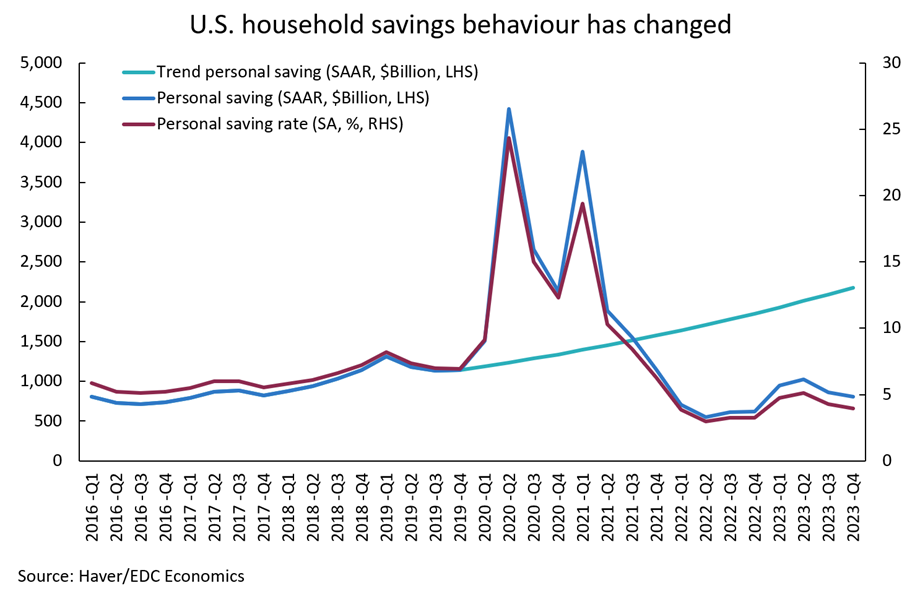
Industrial policy and congressional funding of bills intended to drive innovation and competitiveness will also take the wheel in driving growth. Taken together, industrial policies tabled over the past three years represent dynamic and forward-looking stimulus to revive U.S. productivity. U.S. President Joe Biden’s landmark Inflation Reduction Act is investing around US$300 billion in deficit reduction and US$369 billion in energy and climate change projects over the next decade to reduce carbon emissions by 40%.
Another US$1.2-trillion is also built into the Infrastructure and Job Act of 2021—US$500 billion of which is intended for new investments in transportation infrastructure and electric vehicles (EVs). The CHIPS & Science Act of 2022 contributes US$280 billion in funding for R&D, as well as manufacturing for semiconductors.
As the U.S. election draws near, an increasingly polarized political landscape could impact Canada-U.S.-Mexico trade, given the high degree of economic integration across the continent, says David Weiner, EDC’s regional vice-president for the United States, who is based in Dallas, Texas.
“Depending on the ultimate outcome of the elections, we may see more protectionist policies in the U.S. CUSMA is up for its first review in 2026 and one or more of the signatories could decide to push for changes to the agreement,” Weiner says.
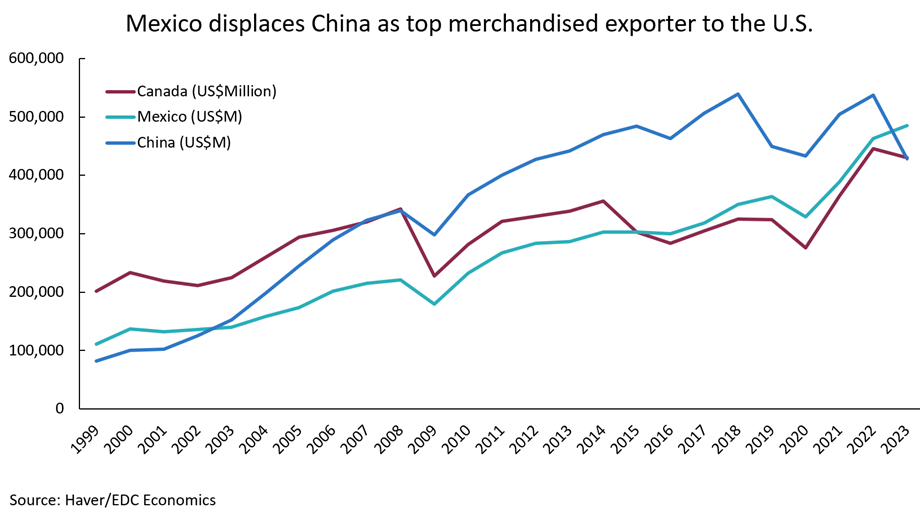
Mexico’s economy has long been tied to the United States, but now that it’s overtaken China as the second-largest exporting nation to the U.S., Mexico’s economic outlook is rosier than ever.
Mexico displacement of China as a steady and reliable supply chain partner to the U.S. is gaining traction. Businesses seeking less politically fraught supply chain partners are turning to Mexico to mitigate disruptions. Several international operators, including electric vehicle and EV-battery producers, are investigating moving, or expanding, operations to Mexico. Its proximity is an important access point to the U.S. market for business investments to Mexico, which has grown on average 17.6% per year between 2021 and 2023.
Jorge Rave, EDC’s regional vice-president, Latin America and the Caribbean, says Mexico is a winner in what came out of COVID-19 with the supply chain crisis and nearshoring.
“The idea of nearshoring was around 10 or 15 years ago, and this is the first time where Canadian companies operating in other parts of the world are coming back to North America. They’re really interested in the supply chain,” says Rave.
With inflationary pressure easing in Mexico, as in the U.S., the country’s central bank—Banxico—has moved ahead of the U.S. Federal Reserve to cut its policy interest rate by 25 basis points in their March 2024 meeting. The action means the peso will be affected by first-mover disadvantages, but the country’s real GDP is, nevertheless, forecast to grow by 2.4% this year and 2.2% in 2025. The speed of monetary policy adjustment will be well-calibrated to ensure that inflation meets the government’s policy target.
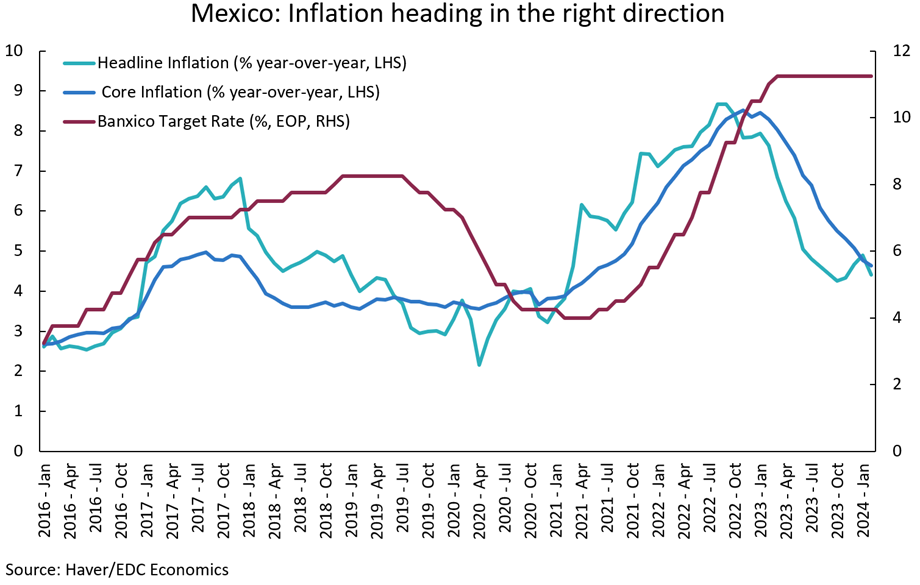
Demand for goods, services and tourism from neighbouring U.S. will continue to be high, ensuring the peso remains strong, at least until the interest rate differential between the Federal Reserve and Banxico becomes more pronounced next year. Until then, the peso is expected to trade around 17.75 pesos to the U.S. dollar, then weaken to 19.24 pesos in 2025.
Business and public investments are also seeing growth. Of note, nearshoring activities will help fuel industrial production, particularly in construction, manufacturing, wholesaling, and distribution. Mexico is also open for Canadian investment and exports in cleantech, energy and agri-food, says Rave.
“We have a water and wastewater crisis, so cleantech will be quite significant in that area. Advanced manufacturing in auto and aerospace sectors will benefit from Mexico being ripe for investment. We have opportunities for investing in better quality agri-food products. We’re seeing Canadian presence in all that supply chain. Mexico is one of those places where they have all the conditions rights for Canadian companies,” he says.
Domestically, low unemployment, wage increases and remittances have sustained Mexican consumers navigating the past year. Although the rate of hiring has dropped from the post-pandemic rush, unemployment remains below 3%, creating one of the tightest labour markets in 20 years.
Workers also received a wage hike of 14.4% earlier this year, similar to a pay rise a year ago. Sustained wage increases are a platform for the candidate of the current presidential election and may result in further rises after a leader is chosen.
The June election could lead to the historic election of a woman for president, either leading ruling party favourite Claudia Sheinbaum or opponent Xóchitl Gálvez. The diaspora continues to send back remittances as well; last year, US$63 billion flowed into Mexico, an increase of 3% over a year ago.
You should also check out
A key trading partner, Mexico offers many opportunities for Canadian companies. This guide highlights the country’s main business sectors and outlines the risks and benefits of expanding into these markets.
As Mexico and the U.S. show all the signs of rallying after the past year’s economic turmoil, Canada’s soft domestic performance and elevated inflation continue to slow advances. After having the slowest post-pandemic growth of just 1.1.% last year, the country faces another year of below-average growth, caused by indebted households, cautious consumers and high borrowing cost.
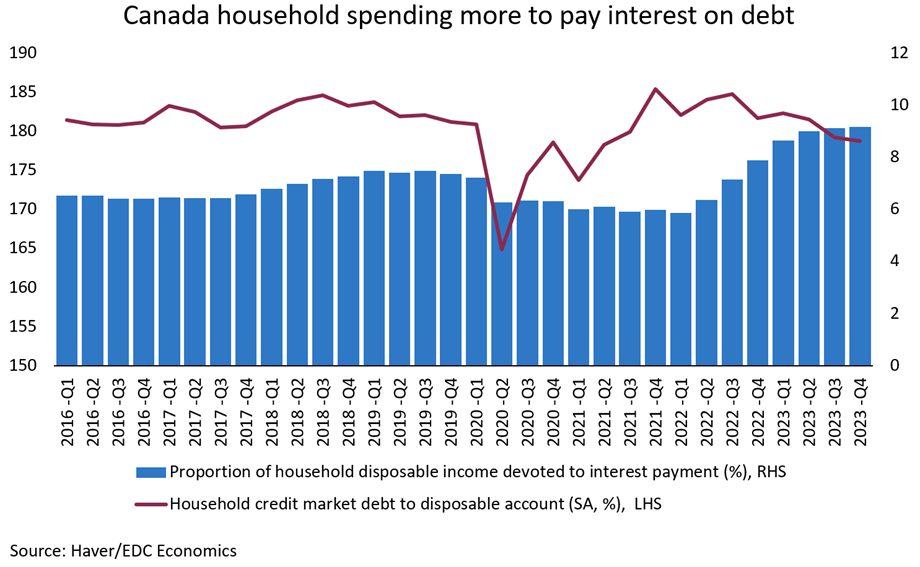
Yet, proximity to North America’s other robust economies is expected to eventually fulfil the adage that “a rising tide lifts all boats.” Demand for Canadian products by the U.S. and optimism about lower interest rates on future borrowing by businesses and consumers, will boost the economy and lead to a brighter outlook in 2025.
To an extent, a lack of consumer confidence is the driving force behind the country’s lacklustre growth. Where Americans have burned through their pandemic stockpiles, Canadians continue to shore up savings in response to fears of skyrocketing grocery bills, peak interest rates at mortgage renewal and threat of recession. High inflation, soaring rents and significant personal debt have kept consumers’ hands firmly in their pockets.
Canadian households are now spending 3.3% more of their disposable income on interest payments on debt than they did at this time in 2022. The result is a focus on paying down debt rather than spending on discretionary items or on big-ticket items such as vehicles, new homes and renovations.
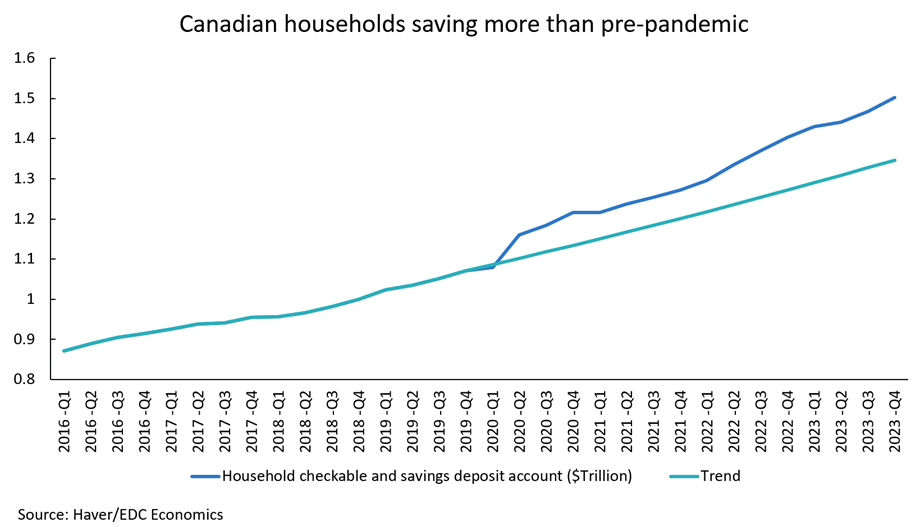
Canada’s labour market has also cooled, compared to the resiliency witnessed in both the American and Mexican economies. The pace of hiring following the initial post-pandemic frenzy has slackened, although job gains remain above historical standards. Unemployment has also risen from 5% in January 2023 to 6.1% in March 2024, in part due to an influx of 1.3 million new immigrants entering the country in 2023. One thing favouring Canadian households is that wages remain high. Wage growth went from 4.8% year-over-year in October 2023 to 5% in March this year.
Although soft domestic growth is forecasted, weaker demand will also ease price increases as inflation slowly creeps back to the Bank of Canada’s desired 2% policy goal. This will take time, given sticky core prices on key components, with the Bank of Canada expected to gradually cut its benchmark rate mid-year once core inflation hits the 1% to 3% range.
You should also check out
With timely insights and financial analysis from our experts, Export Development Canada can help you enter new markets, grow your global business, and reduce risks with confidence.
The outlook for exporters, is slightly better, mostly because of U.S. demand for crude oil, agri-foods, machinery and equipment, and consumer goods. Stronger demands for exports will be needed to support the economy, with a GDP growth of 0.9% in 2024, before it rebounds to 1.8% in 2025.
On the other hand, economic clout in the U.S. will continue to impact the Canadian dollar. The strong U.S economy will continue to suppress the loonie at US$0.74. There’ll be an uptick to US$0.78 in 2025, once the Canadian economy is on firmer ground and oil flows through the new Trans Mountain Expansion (TMX) pipeline to tidewaters in Asia-Pacific where prices are expected to be better.
Although interest rates may curtail short-term spending for businesses, long-term capital plans are likely to remain intact, along with plans to retain the existing workforce. As borrowing costs begin to ease in the second half of this year and demand conditions improve, business investment is likely to pick up next year.
The outlook for 2025 is brighter. With inflation cooling and interest rates easing, consumers are likely to be less cautious and can tap into their sizable savings to boost real GDP growth by 1.8%. Yet, with the U.S. and Mexico—and 62 other countries—holding national elections in 2024, the risk to the economic outlooks are bound to be uncertain.
How EDC can help
Export Development Canada (EDC) offers several solutions, including market intelligence and business connections, to support Canadian companies in their global expansion. Our sector-focused teams have a range of knowledge and expertise.
“We have local knowledge of how to do business in different markets, but we also have the right people who have the connections, and we can leverage that benefit to Canadian exporters,” says Jorge Rave.
“We have a significant and strong Team Canada, including the Trade Commissioner Service, as well as our guides on local culture and doing business as a Canadian exporter.”
- Accessing the U.S. market should start with learning how to navigate and leverage the Canada-United States-Mexico-Agreement (CUSMA) and understand how the U.S. Buy America policy can impact business.
- EDC’s Export Help Hub covers the globe and can connect you with EDC trade advisors who can answer your questions, help you understand your challenges and help you find solutions for them. They specialize in markets and strategies and customs and regulation requirements.
- EDC offers the Business Connections Program, which promotes Canadian export capabilities to international buyers.
For Canadian exporters who need to mitigate risk, EDC offers financial and risk management solutions and tools.








